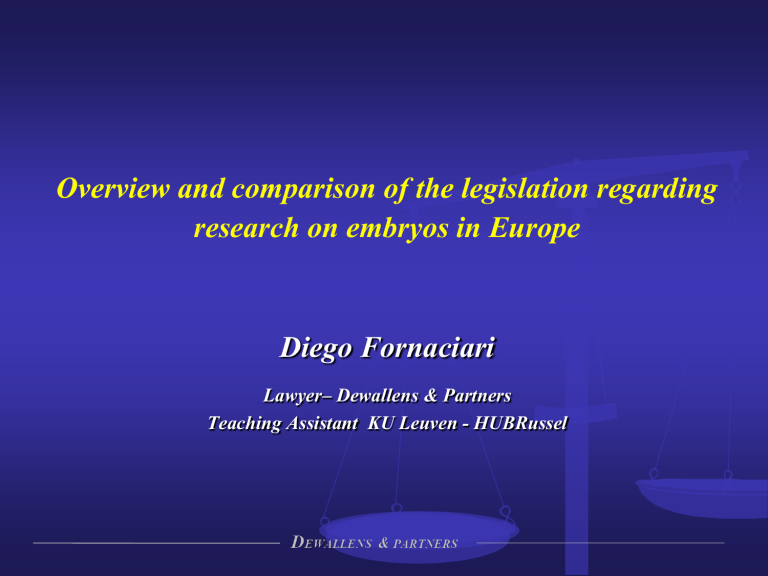
Overview and comparison of the legislation regarding
research on embryos in Europe
Diego Fornaciari
Lawyer– Dewallens & Partners
Teaching Assistant KU Leuven - HUBRussel
Introduction
•
Bill of 20 march 2001 regarding the research on embryos in vitro
•
Three objectives:
•
To determine the conditions to perform research on
supernumerary embryos or on embryos created for research
purposes
•
To oppose research or treatment for eugenic purposes
•
To prohibit reproductive cloning of humans
•
Article 9 and further: Establishment of the Federal commission for
medical and scientific research on embryos in vitro
Overview
1. The Law regarding research on embryos in vitro
2. Further legislative initiatives
3. Research on embryos in vitro in other European
countries
4. Current topics
Embryo Law
Research on supernumerary embryos is allowed
Conditions:
Therapeutic purpose or contribution to a better knowledge
about fertility, etc.
The research is founded on the most recent scientific findings
and is conform the requirements of correct scientific
methodology
The research is conducted in a licensed laboratory that is linked
to an academic programme for assisted reproduction or human
genetics
Embryo law
Research on supernumerary embryos is allowed
Conditions:
The research is conducted under the supervision of a specialist or a
qualified person
The research is performed on embryos during the first 14 days of
development, the period of freezing not included
There is no other research method that is equally efficient
A favorable advice by the local ethics committee
No negative advice by the FCE
Informed written consent by all the persons involved
Progress report
Embryo Law
It is forbidden:
To place human embryos in animals or to create chimaera or hybrids
To replace embryos on which research has been conducted in humans
To use embryos, gametes and embryonic stem cells for commercial
purposes
To conduct research or treatment for eugenic purposes
Reproductive cloning of humans
Embryo Law
•
Creation of embryos in vitro for research
purposes
•
Very controversial
•
Subsidiarity => the goal of the research cannot
be achieved by research on supernumerary
embryos
Overview
1. The Law regarding research on embryos in vitro
2. Further legislative initiatives
3. Research on embryo’s in vitro in other European
countries
4. Current topics
Further legislative initiatives
•
Only one amendment
•
Law of 6 July 2007 regarding medically assisted
reproduction and the destination of
supernumerary embryos and gametes
•
Human Tissue Act of 19 December 2008
Law regarding medically assisted
reproduction
•
Non-remunerated use of supernumerary embryos in a
scientific research programma is allowed
•
Trade in supernumerary embryos is forbidden
•
Agreement with explicit consent
•
Consent can be withdrawn until the start of the research
programme
Human Tissue Act
•
Definition “human tissue” and “embryo”
•
Something new?
•
Article 11: health related information
concerning the donor with significant
importance
•
Secondary use of human tissue
Overview
1. The Law regarding research on embryos in vitro
2. Further legislative initiatives
3. Research on embryos in vitro in other European
countries
4. Current topics
Research on embryo’s in vitro in other
European countries
•
Research on supernumerary embryos
•
Embryos created for the purpose of
research
Overview
1. The Law regarding research on embryos in vitro
2. Further legislative initiatives
3. Research on embryo’s in vitro in other European
countries
4. Current topics
Current topics
• Consitutional Court Belgium 5 October 2011
• Difference between embryos in vivo and vitro
• Children rights and research on embryos
Current topics
• Directive 98/44/EG on the legal protection of
biotechnological inventions
• Uses of human embryos for industrial or commercial
purposes is unpatentable
• European Court of Justice: C-34/10 – Judgment 18
October 2011
• A stem cell obtained from a human embryo at the
blastocyst stage?
Current topics
• any human ovum after fertilisation, any non-fertilised
human ovum into which the cell nucleus from a mature
human cell has been transplanted, and any non-fertilised
human ovum whose division and further development
have been stimulated by parthenogenesis constitute a
‘human embryo’
• Only use for therapeutic or diagnostic purposes which is
applied to the human embryo and is useful to it is
patentable => not scientific research
Current topics
• New case: C-364/13 – 28 Juin 2013
• Are unfertilised human ova whose division and further
development have been stimulated by parthenogenesis,
and which, in contrast to fertilised ova, contain only
pluripotent cells and are incapable of developing into
human beings included in the term "human embryos" in
Article 6(2)(c) of Directive 98/44/EC1 on the Legal
Protection of Biotechnological Inventions?
Current topics
• Affaire Costa et Pavan v. Italy – European Court of
Human Rights
• Legality of PGD in Italy
• Similar issues
Questions?
[email protected]












